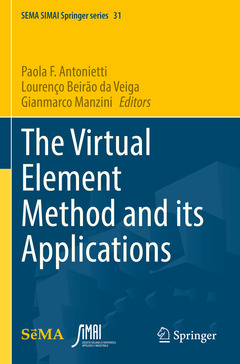The Virtual Element Method and its Applications, 1st ed. 2022 SEMA SIMAI Springer Series, Vol. 31
Coordonnateurs : Antonietti Paola F., Beirão da Veiga Lourenço, Manzini Gianmarco

The purpose of this book is to present the current state of the art of the Virtual Element Method (VEM) by collecting contributions from many of the most active researchers in this field and covering a broad range of topics: from the mathematical foundation to real life computational applications.
The book is naturally divided into three parts. The first part of the book presents recent advances in theoretical and computational aspects of VEMs, discussing the generality of the meshes suitable to the VEM, the implementation of the VEM for linear and nonlinear PDEs, and the construction of discrete hessian complexes. The second part of the volume discusses Virtual Element discretization of paradigmatic linear and non-linear partial differential problems from computational mechanics, fluid dynamics, and wave propagation phenomena. Finally, the third part contains challenging applications such as the modeling of materials with fractures, magneto-hydrodynamics phenomena and contact solid mechanics.
The book is intended for graduate students and researchers in mathematics and engineering fields, interested in learning novel numerical techniques for the solution of partial differential equations. It may as well serve as useful reference material for numerical analysts practitioners of the field.
1 Tommaso Sorgente et al., VEM and the Mesh.- 2 Dibyendu Adak et al., On the implementation of Virtual Element Method for Nonlinear problems over polygonal meshes.- 3 Long Chen and Xuehai Huang, Discrete Hessian Complexes in Three Dimensions.- 4 Edoardo Artioli et al., Some Virtual Element Methods for Infinitesimal Elasticity Problems.- 5 Lourenço Beirão da Veiga and Giuseppe Vacca, An introduction to second order divergence-free VEM for fluidodynamics.- 6 Gabriel N. Gatica et al, A virtual marriage à la mode: some recent results on the coupling of VEM and BEM.- 7 Daniele Boffi et al., Virtual element approximation of eigenvalue problems.- 8 David Mora and Alberth Silgado, Virtual element methods for a stream-function formulation of the Oseen equations.- 9 Lorenzo Mascotto et al., The nonconforming Trefftz virtual element method: general setting, applications, and dispersion analysis for the Helmholtz equation.- 10 Paola F. Antonietti et al., The conforming virtual element method for polyharmonic and elastodynamics problems: a review.- 11 Edoardo Artioli et al., The virtual element method in nonlinear and fracture solid mechanics.- 12 Sebastián Naranjo Álvarez et al., The virtual element method for the coupled system of magneto-hydrodynamics.- 13 Peter Wriggers et al., Virtual Element Methods for Engineering Applications.
Lourenço Beirão da Veiga is a full professor in numerical analysis at the University of Milano-Bicocca, Italy. His research mainly concerns the development and theoretical analysis of numerical methods for partial differential equations, with a particular focus on solid and fluid mechanics. His more recent interests are on novel and nonstandard methodologies such as isogeometric analysis, mimetic finite differences, and virtual element methods.
Gianmarco Manzini is a research director of the Consiglio Nazionaledelle Ricerche in Pavia, Italy and a senior scientist at the Los Alamos National Laboratory in Los Alamos, New Mexico. His research interests mainly concern the design and implementation of numerical methods for partial differential equations, with a special focus on numerical methods for polygonal and polyhedral meshes such as finite volumes, mimetic finite differences, and virtual element methods.
Date de parution : 10-2023
Ouvrage de 605 p.
15.5x23.5 cm
Date de parution : 10-2022
Ouvrage de 605 p.
15.5x23.5 cm
Thème de The Virtual Element Method and its Applications :
Mots-clés :
Virtual Element Method; Galerkin Methods; Polygonal and Polytopal Meshes; Linear and Nonlinear Partial Differential Equations; Discrete Hessian Complexes in Three Dimensions; Elasticity; Divergence-free Methods for Fluidodynamics; Boundary Element Methods; Eigenvalue Problems; Oseen Equation; Helmholtz Equation; Polyharmonic Problems; Nonlinear and Fracture Solid Mechanics; Magneto-Hydrodynamics; Fractured Materials; Contact problems
